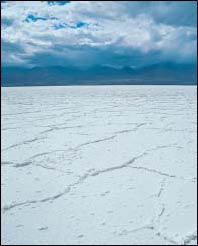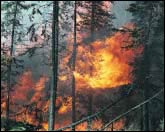Provincial and Territorial Impacts
Regional Impacts – Yukon
There is broad scientific consensus on the reality of climate change. It is happening, and it has serious implications-for our health, our economy and our future.
Human activities, including the heavy use of fossil fuels for heating, transportation and electricity, release greenhouse gases that are accumulating and causing global warming. Average global temperatures are rising – the 20th century was the warmest the world has seen in 1,000 years, and the 1980s and 1990s were the warmest decades on record. As a northern country, Canada will feel the impacts of climate change morethan most countries.
In the Yukon, both temperature and precipitation are expected to increase due to climate change. Climate models project that over the next century, temperatures could rise by 2 to 6░C. Fall storms and day-to-day weather variability are also predicted to increase. These climate changes will have profound effects on ecosystems and quality of life.
Northern landscapes
Permafrost, or perennially frozen ground, can be found in a significant portion of the Yukon. In the southern Yukon, permafrost is discontinuous and may only be present beneath 10 percent of the land area. Further north, the proportion of permanently frozen land increases. In a large part of the Yukon, permafrost is only a few degrees below 0░C. If the climate warms by up to 5░C in the next 50 to 100 years, seasonal thaw will increase and permafrost will become thinner or ultimately disappear.
 Permafrost melt will increase the risk of landslides, which damage infrastructure, reduce water quality, and harm fish and wildlife. It may also substantially alter ecosystems and landscapes in areas such as the Old Crow flats. Permafrost melt also threatens the structural integrity of older buildings, water supplies and waste disposal structures.
Permafrost melt will increase the risk of landslides, which damage infrastructure, reduce water quality, and harm fish and wildlife. It may also substantially alter ecosystems and landscapes in areas such as the Old Crow flats. Permafrost melt also threatens the structural integrity of older buildings, water supplies and waste disposal structures.
Industry
Climate change has the potential to significantly affect existing and future Yukon commercial and industrial activity, with impacts on the territory's economy. Changes to precipitation could require costly upgrades and redesign of tailing dams and water diversion structures in the Yukon's mining industry. As well, an increase in the frost-free period could affect access to many oil and gas exploration sites, now reached via winter roads built on frozen ground. More erratic winter conditions could affect the developing film production sector, as one of the major factors in its success in the Yukon has been the ability to provide snow much earlier and much later than in other locations.
Yukon on the other hand, longer, warmer summers could increase the number of visitors to the Yukon and increase the growing season to enable cultivation of a wider variety of crops and increased yields.
Life on the land
 Climate warming will increase the availability of food for plant-eating animals. However, changes in the timing and location of food sources, an increase in parasites and insect-borne disease, and more insect harassment may lead to declines in some animal populations. Caribou herds may be especially sensitive to these changes.
Climate warming will increase the availability of food for plant-eating animals. However, changes in the timing and location of food sources, an increase in parasites and insect-borne disease, and more insect harassment may lead to declines in some animal populations. Caribou herds may be especially sensitive to these changes.
For birds in northern regions, warming may extend nesting periods, provide more food for young, and decrease chick mortality. Conversely, in the southern regions, warming may reduce breeding and forage habitats.
Forests
 In central Yukon, the number of forest fires and the amount of hectares burned has been increasing since the 1960s. This trend is expected to continue into the future, as temperatures warm and lightning storms become more frequent. Spruce Bark beetles killed almost all of the mature white spruce over some 200,000 hectares in the Alsek River corridor in Kluane National Park and in the Shakwak Valley north of Haines Junction between 1994 and 1999. A series of mild winters and springs provided good breeding conditions for the beetles, allowing them to multiply rapidly.
In central Yukon, the number of forest fires and the amount of hectares burned has been increasing since the 1960s. This trend is expected to continue into the future, as temperatures warm and lightning storms become more frequent. Spruce Bark beetles killed almost all of the mature white spruce over some 200,000 hectares in the Alsek River corridor in Kluane National Park and in the Shakwak Valley north of Haines Junction between 1994 and 1999. A series of mild winters and springs provided good breeding conditions for the beetles, allowing them to multiply rapidly.
Water resources
Climate change will likely affect hydropower generation in the Yukon. While the net effect is uncertain, increases in the amount of water runoff may boost hydropower capacity, while possible heavy storms and sediment loading may reduce its potential. Spring flood damage could be more severe and frequent along coastal rivers and streams and throughout Yukon's interior.

Taking Action
Given the potentially serious and long-term nature of the risks associated with these impacts, the only prudent course is to take actions now to reduce the emissions that contribute to climate change. Analysis shows that the impact on Canadian jobs and economic growth associated with reducing greenhouse gas reductions can be kept modest and manageable relative to the strong growth expected over the next decade.
To give a sense of the possible order of magnitude of the impacts on industry, the estimated economic impact of implementing steps one and two in the Climate Change Plan for Canada to meet Canada's Kyoto commitments ranges from -0.4 percent to -1.6 percent of Canada's gross domestic product, dependent on various assumptions.
This is a modest impact relative to the strong economic growth expected over this period. Analysis shows job growth of 1.08 to almost 1.26 million jobs by 2010, compared to just over 1.32 million in a business as usual scenario. That means a delay in job creation of about 62,000 jobs across Canada in the year 2010. By comparison, the Canadian economy is currently creating new jobs at a rate of about 46,000 per month.
Estimates indicate that with the implementation of actions to reduce greenhouse gas emissions, the provincial gross domestic product for Canada's northern territories in the year 2010 would grow to a level that would be about 0.04 percent less than in a business as usual scenario (combined average for the Northwest Territories, Yukon and Nunavut). Growth in new jobs would slow by approximately 0.1 percent. To put this into context, the economy in Canada's northern territories created approximately 240 jobs over the past year.
The impact on personal disposable income by 2010 would be approximately 0.19 percent less than business as usual. Electricity prices could increase by about 0.17 cents/KWh. Gasoline prices are expected to remain at their business-as-usual level in 2010.
An illustrative example of production increases for major industrial emitters in the province as a result of measures to reduce greenhouse gases (national averages) is as follows:
- natural gas would rise by 0.5 cents/million cubic feet, or 0.14 percent
- electricity – coal would rise by 0.14 cents per KWH, or by 1.94 percent
- electricity – gas would rise by 0.04 cents per KWH or 0.60 percent
- electricity – oil would rise by 0.12 cents per KWHor 1.57 percent
These economic forecasts do not reflect the significant environmental and health benefits to be gained by addressing climate change. Taking action will provide broader benefits including cleaner air, reduced health costs and other environmental and social benefits for Canadians.
Canada's approach to reducing greenhouse gas emissions is designed to minimize costs and maximize opportunities for Canadian technology. It envisions an economy that is based on cleaner sources of energy, using leading edge technologies. The Plan proposes strategic investments in innovative climate change proposals and the creation of a Partnership Fund that will cost-share well as municipalities, Aboriginal communities and the private sector.
By drawing on Canadian innovation, and by ensuring that different sectors of the economy, regions and consumers play a role in taking action on climate change, the impact is more manageable for all. Working together, Canada can position itself as a strong competitor as the world moves to a new, less carbon-intensive economy.
Yukon-based companies and communities are already showing leadership in meeting the challenges of climate change:
- The Yukon Development Corporation is a government agency of the Yukon Territory, which has two subsidiaries: a public electric utility called the Yukon Energy Corporation, and a multi-stakeholder organization dedicated to promoting and implementing renewable energy and efficiency programs called the Energy Solutions Centre Incorporation. Using both subsidiaries, the Development Corporation is aggressively reducing diesel generation in the Territory, which currently represents 40 percent of their electricity generation.
- The Corporation currently emits 65 percent fewer emissions than in 1990, due in part to reduced electrical load and in part to their comprehensive action plan with cost-effective alternative energy options. For instance, they decided to build a new transmission line to connect isolated, diesel-powered communities to surplus hydro-electric power in order to eliminate Yukon Energy's diesel power base-load capacity altogether and encourage a greenhouse gas emission reduction far below the six percent goal of the future.
- Despite anticipated demand increases, the Yukon Development Corporation is targeting further emissions reductions by linking excess generation capacity to existing electrical transmission systems, and adding more wind and solar generation capacity.
Examples are taken from the public record.
